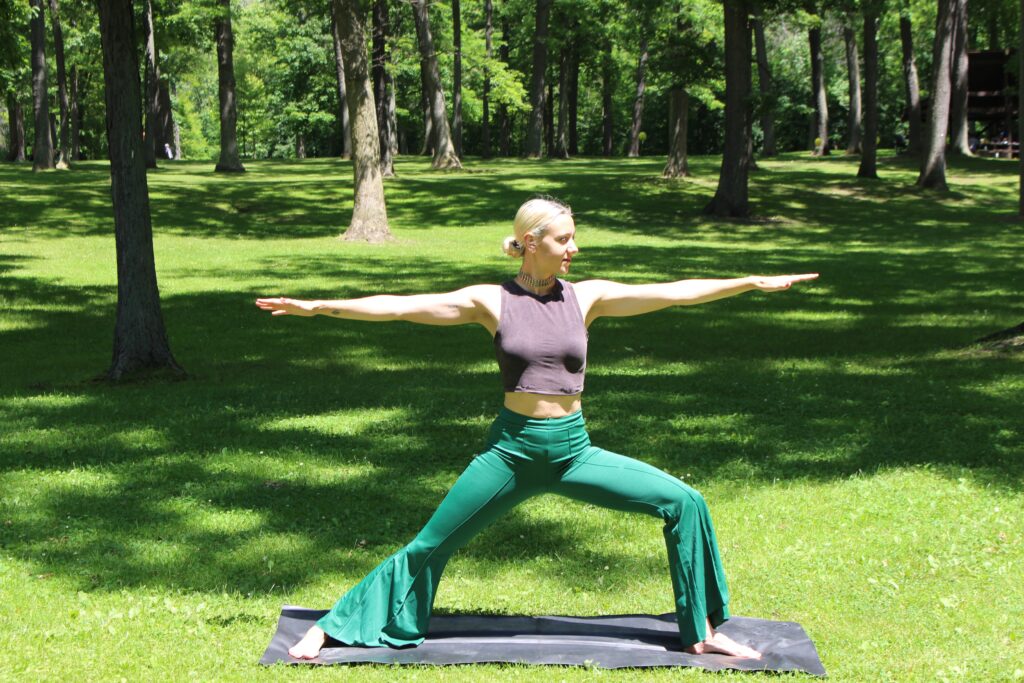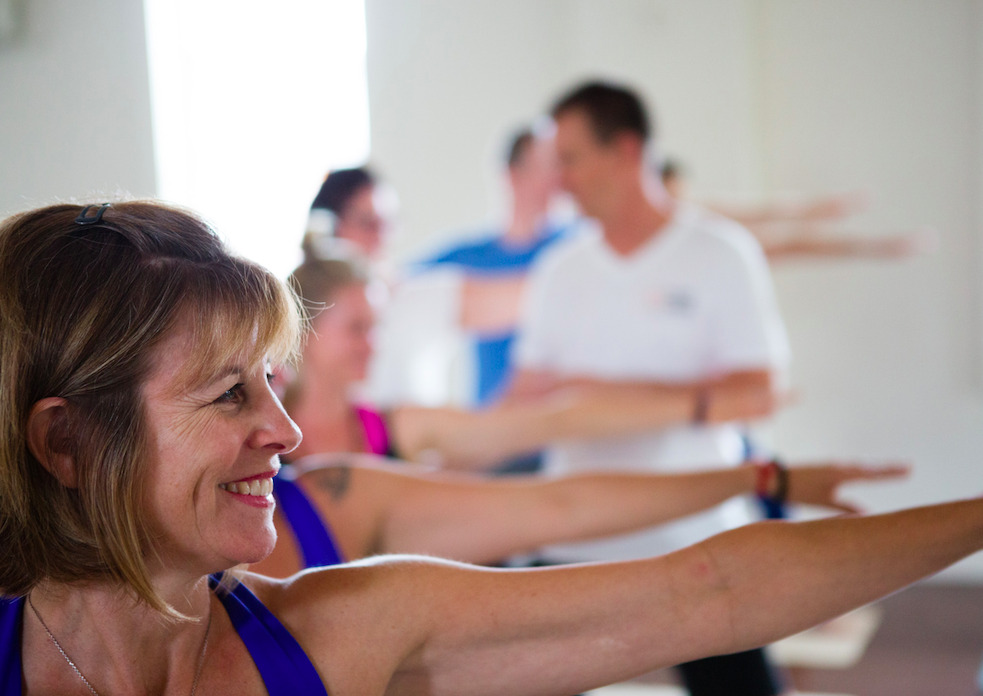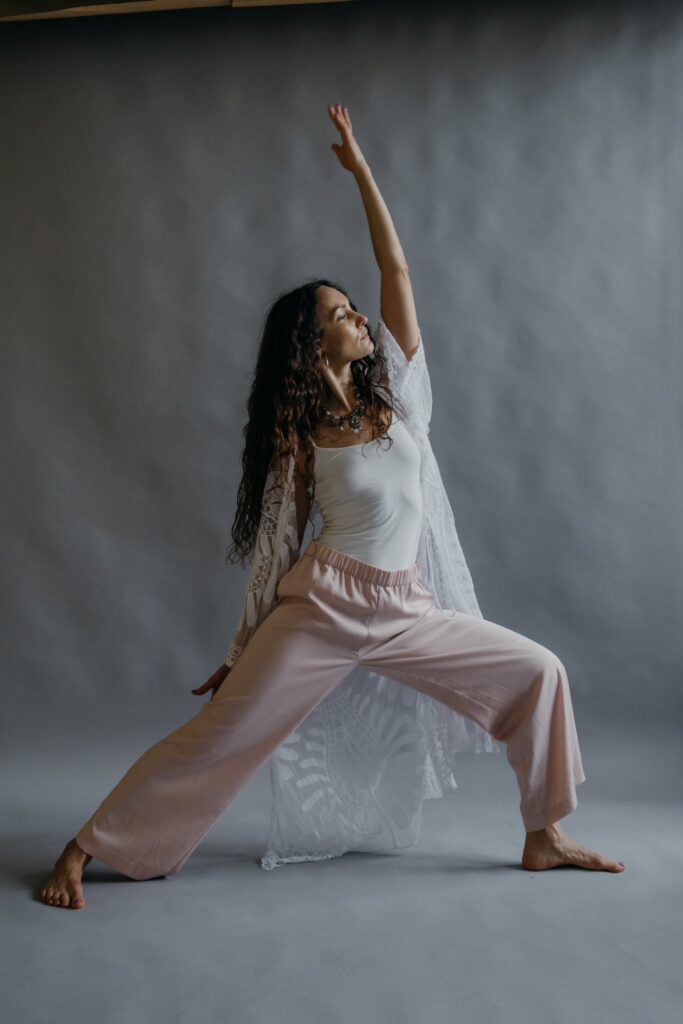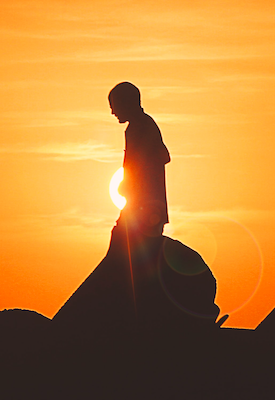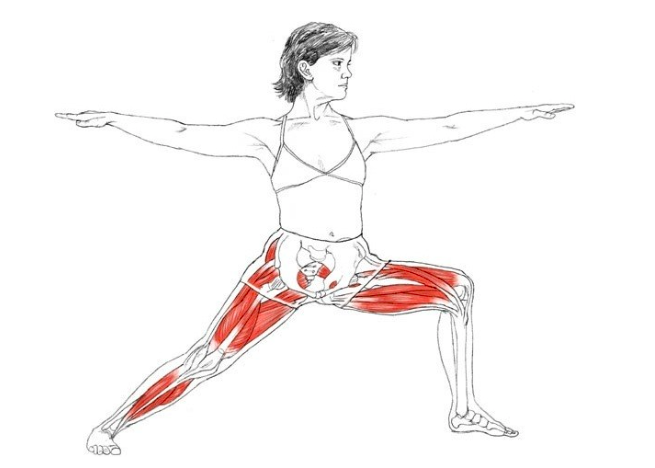Posture In Focus: Warrior II

Let’s unpack the features of Warrior II to enjoy its full benefits in safety.
One of a collection of standing poses (mostly lunges) grouped by the Warrior name, Warrior Two is perhaps one of the most iconic standing poses.
Also known as: Virabhadrasana II
Vira = Hero or Warrior
Bhadra = Good or auspicious
Asana = Pose

Functional Classification
Samasthiti (spine is straight)

Benefits & Effects
Opens chest
Creates expansion in entire body (space in the joints)
Strengthens legs, ankles, knees, and feet-arches
Improves balance
Stretches hips and shoulders
Builds concentration and focus
Warrior Two is a beautiful combination of power and peace. While building strength to many parts of the body, we consciously soften other areas, such as facial muscles and eye gaze.

Vinyasa Krama, Breath and Drishti (The How To…..)
There are many varied and creative ways to enter into Warrior Two. One of the classical ways to enter and come out of the posture is:
- Stand in samasthiti
- Take a stride sideways, feet parallel
- Turn the left foot out, hips remain facing front
- Inhaling, raise the arms from the sides to shoulder-height, palms facing down
- Exhaling, bend the left leg, keeping the knee in line with the ankle, and turn the head and gaze towards the left hand. Maintain a straight back, tilt the pelvis under. Balance the weight between both feet. Breathe naturally. Hold for a few breaths as desired
- Inhaling, straighten left leg, turn head back to centre
- Exhaling, lower arms to sides
- Turn the left foot back to parallel position.
- Bring the feet back together, back to samasthiti
- Repeat on the other side.
This vinyasa krama can be varied for different ages, abilities, and other circumstances.

Alignment and Things to Watch For
Before we look at the areas of the body we run our attention over in this posture, let’s consider why we do that. Alignment cues can serve various purposes.
The very term itself – alignment cues – did not really exist until modern times. They can of course be used to minimise risk of injury, but many people misconceive this to mean that everyone should be doing the exact same thing, all the time.
Ironically, it is approaching yoga postures with a one-size-fits all mentality that is likely to lead to injury. It can also unhelpfully lead to the belief that there must be a right way and a wrong way to move your body.
There is a right way for you, but beware the yoga teacher that expounds a notion of one singular right way of doing any pose.
Yoga is not a choreography. Its beauty comes from each person learning to listen to their unique bodies and their own unique mind-body-emotion experience of being alive. What is right for one may not serve another.
Alignment cues created to avoid unnecessary strain or pressure on human bodies have evolved because of the western world’s adaptation of yoga from something that was traditionally taught one-on-one or to very small groups of people, to something that is often taught to very large groups of people. In this context, they can indeed be useful to help keep participants safe in a big group environment.
But did you know, refinements to a posture’s precision traditionally serves two key purposes, that were not directly related to safety:
MOVEMENT OF PRANA – coordination of breath and body can be used to direct and move energy around the body, better serving the healing process, and ultimately assisting a person’s spiritual evolution, as energy rises to our higher chakras.
STAYING PRESENT – by doing a mental checklist from the ground up where and how your body is placed, keeps your mind grounded to the present moment and less likely to wander off to review past events, or rehearsing the future.
Be kind to yourself and bear these more traditional purposes of ‘alignment’ in mind as you practice, learning to let go of the one-size-fits-all approach. Below are some tips that may help you stay safe, present, and allow prana to flow, but always make the practice yours.
- Press the outer edge of the back foot into the mat and lift the arch of the foot.
- Keep the torso vertically upright (shoulders over hips), and spine neutral (not over-arching).
- Hip and shoulder girdles face the side of the mat while the front foot points towards top of mat. The sacroiliac joint (SI) is a joint that connects the base of the spine (sacrum) with your hip bone. It does have a small amount of mobility, but its primary function is stability, so it’s important to respect its range. Turning the chest to the side can be more challenging for people with more limited SI mobility and may require more spinal rotation. (If the chest is not facing the side, nerves branching into the arms can be compressed and cause tingling).
- Imagine drawing your heels towards one another to activate inner thigh muscles.
- A sensation of external rotation in the front leg prevents the bent knee rolling inwards and dumping undue pressure on the knee joint, specifically the shock-absorbing meniscus tissue and the stablising medial collateral ligament (MCL). Aim to keep the kneecap in line with your second toe.
- Stacking the knee precisely over the ankle can be a useful safety measure. Weight-bearing in the knee increases as the knee moves forward of the ankle (specifically on areas like the stabilising anterior cruciate ligament (ACL). So, encouraging students’ knees not to move forward past the ankle can be a good way to err on the side of caution, especially in a big group class, for people with ACL injuries, people with knee pain or for beginners while people may be building up strength in their quadriceps (thigh muscles). But also let’s recall: your knee extends further out than your ankle every time you take a flight of stairs or walk up a hill. True risk levels may depend on how far further forward the knee is, whether that person is carrying ACL issues, how long the pose is being held for and how strong the practitioner’s lower limbs are*.
- Some people may crunch shoulders up towards the ears. Shoulders drawn back and down can feel more comfortable and release unnecessary tension.

* Observe the father of modern yoga, Krishnamacharya, in a similar lunge posture, intimately familiar with his own body’s limits, moving into a deep lunge with his knee a little further forward than his ankle. Many yoga teachers today would rush to “correct” him, preferring to have codified rules that apply to everyone. Indeed this knee positioning may not be safe or appropriate for everyone, but is an apt reminder of the principles of viniyoga.


Stay present to how each posture feels in your body and practice svadhyaya (self-enquiry) and ahimsa (non-harming) with your precious & unique self.
Onward Sequencing
Some progression ideas may include Half-Moon (Ardha Chandrasana) or Extended Side Angle (Utthitha Parsavakonasana)

Preparations and Counterpose
Some prepatory suggestions may include:
- Sun Salutations
- Seated Bound Angle (Baddha Konasana)
- Tree Pose (Vrikshasana)
- Low Lunge (Anjaneyasana)
- Triangle (Trikonasana)
- Goddess/Horse (Utkata Konasana)
Counterpose examples may include Mountain (Samasthiti), Wide-Legged Forward Fold (Prasarita Paddotanasana) or even repeat a sun saluation.

Modifications & Adaptations
- Reverse Warrior (Viparita virabhadrasana) is accessible by simply moving arms, torso and gaze, lower body stays in place.
- A wider step may better accommodate the ability to lunge more deeply, while a shorter stance may relieve pressure in the knees and help you feel more stable
- Resting the bent leg over the edge of a chair can help your body get a taste for the pose. There is no need to get your thigh parallel to the ground unassisted, especially before your body is ready.
- Experiment with arm posture such as cactus arms or prayer hands
- Try kneeling Warrior II

Contraindications
People with neck issues may opt to keep their gaze to the side of the mat, and people with blood pressure, knee or hip conditions may like to seek the guidance of an experienced yoga teacher or yoga therapist.

Interesting Sidenote: War & Peace?
Many people are intrigued or confused to find postures named for warriors, and those that have delved into the philosophy of yoga may be familiar with the notion of non-violence, so it’s fair to be curious about the postures’ names.
Indeed, part of Patanjali’s Yoga Sutras is the 8 Limbs of Yoga, including the Yamas and Niyamas – a collection of suggested practices and observances for on and off your yoga mat that encourage us to think about how we think and behave towards ourselves and others – and the very first Yama is that of Ahimsa (non-violence or simply ‘do no harm’).
A quick example on the mat: We are practicing non-harming towards ourselves when we don’t allow our ego to push us into poses or depths that are beyond our body’s safe limits.
Quick example off the mat: We are practising non-harming for others when we choose to refrain from gossip, or when we protect other living things.
So, if non-harming is one of the suggested guidelines to progress our spiritual selves, how does the reference to battle fit in? Well, recall that yoga is all about helping us to manage our human condition. Becoming peaceful in our mind, to ourselves, and others is not without effort. We do not simply choose once; it is an ongoing process of observing ourselves and choosing, observing ourselves and choosing, observing ourselves and choosing, often against very ingrained and tempting patterns.
Patanjali summarised humans’ cause of suffering with the klesas, those aspects of our underlying operating system – mostly not even visible to us – that impede our spiritual growth: self-ignorance, ego, attachment, aversion, and fear of misfortune/death. All play a role in being obstacles for us, but we could say that all klesas arise from the first one: self-ignorance (Avidya in Sanskrit).
The analogy of battle can be seen in stories of Krishna and Arjuna, and stories of Shiva, for example. The stories are not glorifying combat or battle, they are stories to be unpacked and interpreted, not taken literally. It is not just yogic texts that employ the use of metaphor, it is a commonly used literary tool in an array of spiritual and religious texts where the lesson is couched in a tale.
The reference to the Vira (‘heroes’ and ‘warriors’) may serve as a reminder to us of the conscious efforts we need to make in our struggle against our own self-ignorance and other obstacles to spiritual freedom.
Written by Nicole Small, The Yoga Institute


Learn more about:
